:::::::::::::::::::::::::::::::::::::::::::::::::::::::::::::::::::::::::::::::::::::::::::::::::::::
Fivehundred Arhats - Gohyaku Rakan 五百羅漢
This is a group of 500 statues, sometimes more, of the disciples of the Buddha.
They are usually shown in very human poses, with very individual faces and expressions.
Many temples are famous for the collection of all these statues.
And we will even find our Daruma san amongst them.
During the Edo period there were many fires in the town and many people lost their lives. Some local lords had a temple with 500 statues erected in their district, so that the relatives could go there and find a face resembling the lost person, pray for it there and perform the proper rites.
My favorites were two temples in Meguro, one with stone statues outside and one with wooden statues in a huge hall.
I will introduce some of these temples here.
The group was already famous in China, but for different reasons.
Read this story at JAANUS:
http://www.aisf.or.jp/~jaanus/deta/g/gohyakurakan.htm
Mark Schumacher has a lot of information, so I have not much to add to this:
Arakan (Rakan)
:::::::::::::::::::::::::::::::::::::::::::::::::::::::::::::::::::::::::::::::::::::::::::::::::::::
Here is a group in autumn splender, in Hiroshima prefecture, where I visited in 2004.
Read more about Buttsuu-Ji here:

三原の佛通寺と三原だるま
http://darumadollmuseum.blogspot.com/2004/11/mihara-daruma.html
:::::::::::::::::::::::::::::::::::::::::::::::::::::::::::::::::::::::::::::::::::::::::::::::::::::
Meguro Temple Rakan-Ji 目黒の羅漢寺
There are strict rules as not to take pictures. The two links will show you some aspects.

http://www.rakan.or.jp/
http://www.rakan.or.jp/kaikan/kaikan.html
.. .. .. English
http://www.rakan.or.jp/english/aramashi/aramashi1.html
Copyright(C) Rakanji 1999-2003.
An article about this temple, with instructions of how to go there.
Wander where the wise ones wink
By SUMIKO ENBUTSU
:::::::::::::::::::::::::::::::::::::::::::::::::::::::::::::::::::::::::::::::::::::::::::::::::::::
Rakanji Temple, Omori Town
A donation of the 22nd local administrator, Sekichu Dayu, the temple took 22 years to complete, finally opening in 1776.
Local administrators at the silver mine, government officials, general citizens.There are the names of people from the inner palace of Edo Castle and the those related to the Tayasu Family, the younger brother of the 9th Tokugawa shogun.
http://www.iwamigin.jp/ginshin/ginshin/e/ginzan/500rakan.html
:::::::::::::::::::::::::::::::::::::::::::::::::::::::::::::::::::::::::::::::::::::::::::::::::::::
Near Iwami Ginzan, Yunotsu hot spring
Rakan Temple, known for its 500 rakan statues, is located just outside the Iwami Silver Mine town. Cross the arched stone bridge and look into the stone cave, where 500 rakan richly expressive images are lined up. The 501 (the actual number) statues expressing people's emotions were made in the middle of the 18th century, a project taking some 20 years. "Sanbyakusui", the great water that gushes out of the stone cave, is also well-known.
http://www.iwamigin.jp/ginshin/ginshin/e/reg/r_ssr03.htm
:::::::::::::::::::::::::::::::::::::::::::::::::::::::::::::::::::::::::::::::::::::::::::::::::::::
Gyokuryuu-In, Takahata

In the Edo Era the monk Ryoo-in (Ryoin) brought from Kyoto via the Japan Sea and Sakata the 500 statues of Rakan (Arhat) that are now enshrined in Gyokuryu-in (Gyokuryu Monastery) in Takahata. It's said that each statue has a different expression.
http://www4.ocn.ne.jp/~yuko2000/okitama-r/takahata/sh/gohyaku.html
:::::::::::::::::::::::::::::::::::::::::::::::::::::::::::::::::::::::::::::::::::::::::::::::::::::::::::::::::::::::::::

source : marippe3.exblog.j
even in stone, for an eternal drink !
. Sake 酒 for rituals and festivals .
. . . CLICK here for Photos of rakan drinking sake !
:::::::::::::::::::::::::::::::::::::::::::::::::::::::::::::::::::::::::::::::::::::::::::::::::::::::::::::::::::::::::::

source : Japan Times
Rahula Rakora sonja from Fan Daosheng
- quote -
Rāhula (born c. 534 BC) was the only son of Siddhartha Gautama (Pāli Siddhattha Gotama), later known as the Buddha, and his wife Princess Yasodharā.
- - - More in the WIKIPEDIA !
:::::::::::::::::::::::::::::::::::::::::::::::::::::::::::::::::::::::::::::::::::::::::::::::::::::::::::::::::::::::::::
The 500 Buddhas of Rakan Temple in Otaru
Not nearly as famous as the Great Buddha of Kamakura or the treasures of Horyuji, but every bit as beautiful are the 500 Buddhas of Rakan Temple in Otaru. You can spend hours admiring the craftsmanship, grace, and humour exhibited in these incredible works of art. Carved in the 1800's by a priest in the Tsugaru region of Aomori in Northern Japan, these are probably the only Buddhist sculptures you will ever see that exhibit a sense of humour.
Some of the sculptures look like space aliens straight out of Star Trek while other look like stereotypical Oyaji (middle-aged men), who are much ridiculed in Japan for their bad manners and bourgeois lifestyles.
The word rakan means disciple of Buddha and these statues represent the 500 followers of Shaka, the Japanese word for the historical Buddha. The statues were carved in Aomori, and were in Morioka (Iwate) and Matsumae (near Hakodate) before coming to Otaru in 1909.
There is an interesting story behind the 500 Rakan Butsuzo.
According to local legend, in 1825 there was a young priest who, despite his age was very much respected by the people of a small Tsugaru village. On New Year's Day, he told the villagers that during the snow melt of that year, a stranger would come from Matsumae and request that he make 500 sculptures of the Rakan. He asked the villagers to go up to the mountains to cut wood in preparation and the villagers complied with his request. Because the trees were so heavy however, the villagers were unable to pull the heavy sledges and request the priest's help.
He came up to the mountain, recited a mantra, and miraculously, the heavy sledges began to move. That spring, the snow melted and, as the priest had predicted, a stranger came from Matsumae and commissioned the priest to make 500 the sculptures.
During the priest's long labours, the villagers took care of the priest, and were amazed by the astonishingly lifelike expressions on the faces of his carvings. Unfortunately, after having completed just 308 statues, the wood ran out and the priest went away. The other statues were completed at a later date.
http://www3.tky.3web.ne.jp/~edjacob/rakan.htm
:::::::::::::::::::::::::::::::::::::::::::::::::::::::::::::::::::::::::::::::::::::::::::::::::::::
Morioka and the Temple with 500 Rakan
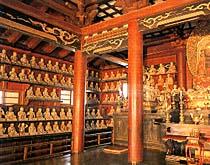
報恩寺には、京都の仏師が造ったという木彫、漆塗の羅漢が500体納められています。なかにはマルコ・ポーロやフビライ像が見られます。
http://www2.city.morioka.iwate.jp/02kikaku/kokusai/ja/j_attractions.html
Wooden statues with laquer finish.
http://www.otarucci.jp/kankou/bunka/bunkazai/bunka006.html
:::::::::::::::::::::::::::::::::::::::::::::::::::::::::::::::::::::::::::::::::::::::::::::::::::::
Odawara, Gohyaku Rakan-Ji 玉宝寺 の五百羅漢

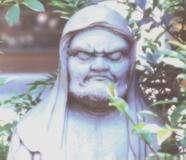
I visited there often. In the compounds was a statue of Daruma san made of stone, with a special face. I now have a laquer statue of Daruma san which has exactly the same kind of face、as you can see above.
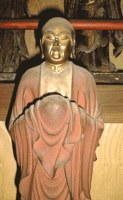
Look at some more here:
http://www.pp.iij4u.or.jp/~jorbkato/rakan1.htm
玉宝寺 五百羅漢を安置する寺として知られ多くの人々は寺名を呼ばないで、多古の五百羅漢という。像は木彫りで立像のものは像長36~60、座像のものは20センチ余である。造立の始まりは享保15年(1730)で、檀家添田氏の夢枕に隣村塚原の地蔵尊が立って造立を勧めたとも、また添田氏がある時秋の洪水で大きな流木を拾おうとすると大蛇であったので殺した処、夜間に無数の小蛇に襲われた夢を見て、一念発起したともいわれる。添田兄弟のうち兄は、僧籍に入り智鉄沙弥となり七年勧進し170体を造ったが、中途で病没したので弟り真澄が後をつぎ宝暦7年(1757)に完成し、寺に安置したという。
http://www.asahi-net.or.jp/~ma6t-nsd/kanagawa/20030302.html
:::::::::::::::::::::::::::::::::::::::::::::::::::::::::::::::::::::::::::::::::::::::::::::::::::::
At the Temple Kita-In 喜多院の五百羅漢さん
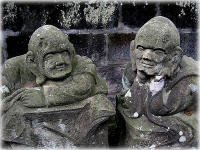
source - Nobuyuki Kawamura 2003
Here is a map of their location within the temple. The shelfs are marked from a to z.
You can click on the shelfs and then on the indivitual thubnails to see them all!
On shelf l is one asleep.
- kawamura rakan
Groups of the Rakan
五百羅漢 団体写真
This one looks like Daruma san himself
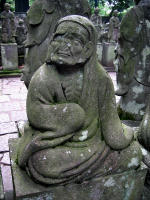
- source - kawamura -
There is one Rakan trying to keep the mouth of Daruma shut
with his hand.
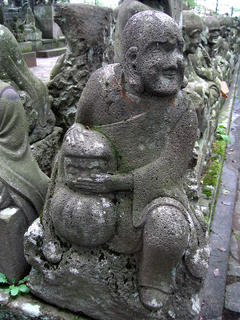
- source - kawamura -
だるまの口をおさえている羅漢がいる
これはまさに庶民の知恵だ。庶民はいささかおしゃべりが好きである。そしておしゃべりは、しばしば禍いを生むのである。この男も、いささか口が軽いのである。口の軽い彼は懸命にダルマの口をおさえて、無言を自らにいい聞かせるのである。口は禍いのもと、ご注意、ご注意という声が、この石像から聞こえてきそうである。
source - kita-in
:::::::::::::::::::::::::::::::::::::::::::::::::::::::::::::::::::::::::::::::::::::::::::::::::::::
five hundred friends,
waiting to touch me -
autumn deepens
Thinking of Meguro, see above, 2005
... ... ...
fivehundred friends
for eternity -
autumn draws near
2004
... ... ...
taking a nap
in the summer breeze -
his heavy head
Mittagsschlaf
in der Sommerbriese -
sein Kopf sooo schwer
My Haiku Gallery
:::::::::::::::::::::::::::::::::::::::::::::::::::::::::::::::::::::::::::::::::::::::::::::::::::::
:::::::::::::::::::::::::::::::::::::::::::::::::::::::::::::::::::::::::::::::::::::::::::::::::::::
Arhats (Rakan)
Als direkte Schüler des Shakyamuni sollen die Arhats übernatürliche Kräfte besitzen, um ihr Leben zu verlängern, damit sie anderen helfen können, die Erleuchtung zu erlangen. Sie werden besonders von der Tendai- und der Zen-Sekte verehrt.
Arhats haben zwar die Erleuchtung, aber sie haben keine Gelübde zur Erlösung aller Menschen abgelegt, daher stehen sie unter den Bosatsu.
Meist in Gruppen zu 16 (Juuroku Rakan) oder 500 (Gohyaku Rakan). Bei 500 Figuren sind alle verschieden und jeder Mensch findet bestimmt ein Gesicht, das einem Verstorbenen entspricht. In der Stadt Edo stiftete die Regierung nach einem großen Brand einen Tempel mit 500 Rakan-Figuren (z.B. Tempel Daionji in Meguroo, Tookyoo), weil bei einem Feuer so viele Menschen verbrannten und nicht identifiziert werden konnten. Da sie also kein indi~vidu~elles Grab hatten, konnten die Angehörigen wenigstens an so einem Tempel nach dem Gesicht des Verstorbenen suchen und dort ihre Totenrituale verrichten.
Es gibt zwei Arten von Arhat-Portraits, die von China nach Japan kamen:
1. Arhats in der Kleidung von chinesischen Laien, im Stil des Ri Ryuumin (Li Long-mian).
2. Arhats mit grotesken Formen, im Stil des chinesischen Zen-Priesters Zengetsu (Chan-yue).
Es gibt auch alte Bilder japanischer Art, z.B. die Wandgemälde der dreistöckigen Pagode des Tempels Jooruriji in Kyooto.
16 Statuen dieser Arhats befinden sich oft im zweiten Stock des Eingangstores eines Zentempels.
Bilder der 16 Arhats finden sich in China seit der Sung-Zeit und in Japan seit der Kamakura-Zeit.
Arhats haben meistens kahle Köpfe und tragen einfache Priestergewänder.
Beschreibung der 16 Arhats nach Tanaka (6):
..... 1. Hindoo Rabara Dasha.....
Auch als identisch mit Binzuru angesehen.
Weiße Augenbrauen; faltiger Hals; sitzt in einer Felshöhle und betrachtet die Wellen. Hält in beiden Händen eine Reliquien~pagode, in der sich eine Buddhastatue befindet.
..... 2. Kanaka Bassa.....
Beleibte Figur. Sitzt auf einem Felsen. In der rechten Hand einen Wedel. Neben ihm steht ein Mann aus den Westgebieten Chinas mit gefalteten Händen.
..... 3. Kanaka Hatsuri Dasha.....
Lange schwarze Haare und Augenbrauen. In den Händen einen Rosenkranz. Sitzt auf einem Sitz und betrachtet einen Wasserfall. Neben ihm steht sein Diener, ein Dämon mit drei Augen, der mit beiden Händen ein Schwert hält.
..... 4. Sobinda.....
In der rechten Hand einen Donnerkeil, in der linken eine Glocke. Sitzt auf einem Sitz. Neben ihm steht ein Mann in chinesischer Kleidung mit gefalteten Händen.
..... 5. Nakura.....
Lange weiße Haare und Augenbrauen. In der Hand einen Federwedel. Sitzt auf einem Felsen. Betrachtet Wasservögel. Neben ihm ein Diener mit einem langstieligen Räucherbecken.
..... 6. Baddara.....
Kurzes Haar und lange Augenbrauen. Sitzt auf einem Sitz. Hält einen Rosenkranz in beiden Händen.
..... 7. Karika.....
Sitzt auf einer Kiefernwurzel, das linke Bein nach unten hängend. Rechte Schulter frei. Rechte Hand zur Faust, linke berührt einen Tiger.
..... 8. Bashara Hottara.....
Rechte Schulter frei. Zieht gerade mit aller Macht einem Drachen einen Zahn.
..... 9. Jubakuka.....
Sitzt auf einem Stuhl. Hält einen Wedel. Neben ihm steht eine schöne Frau, die Pfirsische auf einem Tablett trägt.
..... 10. Handaka Sonja 半託迦 .....
Hält eine Räucherbecken in der Hand, leht an einen Wandschirm, betrachtet etwas in der Ferne. Im Hintergrund ein wilde zerklüfteter Fels. Neben ihm ein Diener mit einer Blumenvase mit Lotusblüten.

- source and more photos -
..... 11. Ragora.....
In der Hand einen Rosenkranz. Neben ihm ein Tier. An einen Zweig gelehnt ein Räucherbecken.
..... 12. Nakasaina.....
Sitzt auf einem Sitz, hält eine Sutrarolle in beiden Händen. Neben ihm ein Diener mit einem dampfenden Räucherbecken. Im Hintergrund Bananenblätter.
..... 13. Inkada.....
Sitzt auf einem Felsen. Spielt mit einem Löwenkind. Im Vordergrund Wellen.
..... 14. Banabashi.....
Sitzt auf einer Kiefernwurzel. Stützt sich auf einen langen Stab. Neben ihm ein Kind mit einem Medizinkorb.
..... 15. Ashita.....
Sitzt auf einer Wurzel. In der Hand einen Rosenkranz. An den Baum gelehnt ein Räucherbecken.
..... 16. Chuuda Hantaka.....
Im vollen Meditationssitz auf einem mit Gras bewachsenen Felsen. Um ihn herum wilde Vögel in den Falten seines Gewandes.
.................................................................................
Die 10 Großen Jünger des Shakyamuni
(Juudaideshi 十大弟子)
. . . CLICK here for Photos !
Die 10 wichtigsten Schüler des Shakyamuni. Stehen um die Figur des Shaka Nyorai. Es müssen nicht unbedingt 10 Statuen sein. Sie gehören im weitesten Sinne zu den Arhats.
Mit rasierten Köpfen, im Asketengewand oder im Priestergewand im chinesischen Stil. Mit gefalteten Händen oder mit bestimmten Gegenständen.
..... Ananda (Aananda).....
Erster mit gutem Gedächtnis und Verständ~nis der Lehre, da er sich immer neben Shakyamuni aufhielt und dessen Worte hörte (tamon daiichi). Er diktierte später die Sutras, als sie aufgeschrieben wurden. Es heißt, er sei der Cousin des Shakyamuni. Er sei besonders schön gewesen und habe einige Freundinnen gehabt.
..... Anaritsu, Ananritsu (Aniruddha).....
Erster in Einsicht des Himmelsauges. Da er von seinem Meister gescholten wurde, weil er eingeschlafen war, übte er sich Tag und Nacht, bis er blind wurde. Danach öffnete sich sein "geistiges" Auge.
..... Furuna (Puurna).....
Erster beim Predigen. Ältester der 10 Jünger. Sohn eines reichen indischen Kaufmannes. Japanisches Sprichwort: So sprachgewand wie Furuna (Furuna no ben).
..... Kasennen (Kaatyaayana).....
Erster in der Diskussion über die buddhistische Lehre. Sohn eines reichen Brahmanen in West~indien; wurde im Hirschpark von Shakyamuni bekehrt.
..... Makakashoo, Daisashoo (Mahakasyapa).....
Erster, der sich von Anhaftungen an weltliche Dinge befreit.
..... Mokkenren, Maka Mokukenren (Maudgalyaayana).....
Erster in übernatürlichen Kräften. Er erlöste die eigene Mutter, indem er selbst in die Hölle ging (Urabon-e). Später entstand das Ritual "Segaki" am 16. August, bei dem den hungernden und dürstenden Geistern Essen und Wasser gespendet wird.
..... Ragora (Rahula).....
Erster im esoterischen Buddhismus, nach strenger Askese beherrscht er alle Gebote. Es heißt, er sei als Sohn des Shakyamuni geboren worden, als dieser noch verheiratet in dieser Welt lebte. Ragora verließ wie sein Vater Haus und Familie. Beim Tod des Shakyamuni war er nicht anwesend, trug später aber wesentlich zur Aufzeichnung der Schriften bei.
..... Sharihotsu (Sariputra).....
Erster in der Weisheit.
..... Subodai, Shubodai (Subhuuti).....
Erster in Verständnis der Lehre über das NICHTS im Mahayana-Buddhismus. Arroganter Sohn eines Brahmanen, der zum Buddhismus bekehrt wurde.
..... Upari, Ubari (Upali).....
Erster im Beachten religiöser Vorschriften.
. Buddhastatuen ... Who is Who .
Ein Wegweiser zur Ikonografie
von japanischen Buddhastatuen
Gabi Greve, 1994
Edo, the Hall of Five Hundred Rakan in Honjo 五百羅漢堂 - 本所五ツ目
:::::::::::::::::::::::::::::::::::::::::::::::::::::::::::::::::::::::::::::::::::::::::::::::::::::
. Onipedia - 鬼ペディア - Oni Demons - ABC-List - .

五百羅漢図 500 Arhats and 「六道 地獄」 Rokudo Hell
Kano Kazunobu 狩野一信 (1816 - 1863)
:::::::::::::::::::::::::::::::::::::::::::::::::::::::::::::::::::::::::::::::::::::::::::::::::::::::::::::::::::::::::::
[ . BACK to DARUMA MUSEUM TOP . ]
[ . BACK to WORLDKIGO . TOP . ]
- ##rakan ##arhats -
:::::::::::::::::::::::::::::::::::::::::::::::::::::::::::::::::::::::::::::::::::::::::::::::::::::::::::::::::::::::::::









4 comments:
the temple of Arhats ~
incense sticks in hand
tears in the eyes
. Meguro Fudo Temple 目黒不動 .
Meguro and Edo
Ganjoojuin 願成就院 Ganjoju- In, Shizuoka
静岡県伊豆の国市寺家83-1 / Jike 83-1, Izunokuni
Along the road of the 裏山 back mountain of the temple are
gohyaku rakan 五百羅漢 statues of the 500 Arhats.
.
http://gokurakuparadies.blogspot.jp/2016/07/ganjoju-in-shizuoka.html
.
Edo meishozue, Pictorial Guide to Famous Places of Edo
the Hall of Five Hundred Rakan in Honjyo Itsutsume (presently, in the Ōshima district, Kōtō Ward) , published in 1834
天恩山五百羅漢寺は本所五ツ目(現・江東区大島)
.
https://edoflourishing.blogspot.com/2020/08/ojima-koto-ward.html
.
Post a Comment